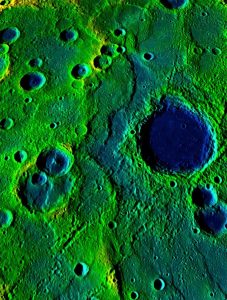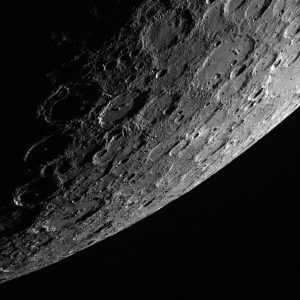Surface:
The first planet from the Sun, Mercury’s small size (4,879 kilometers in diameter- the smallest planet in the Solar System) deceptively hides its extreme nature. Surface temperatures can reach a scorching 800 degrees Fahrenheit (430 degrees Celsius) during the day, only to drop 1,000 degrees Fahrenheit to a nighttime low of -280 degrees Fahrenheit (-170 degrees Celsius). The surface appears very similar to Earth’s moon. Impact craters made from collisions with comets, asteroids, and meteoroids cover much of the planet’s ground.

One of the largest geological features, the Caloris Basin measures approximately 800 miles in diameter (1,300 kilometers). If you were to stand on Mercury and look to the sky during daylight, the sun would appear three times the size as how we see it from Earth. There are also no seasons on Mercury. Its axis has the smallest tilt of any other planet in the Solar System.
Composition:
Unlike Earth, Mercury has no atmosphere to regulate surface temperatures and provide protection from small meteoroids and the solar wind. Instead, it has a thin exosphere created by the very materials an atmosphere shields against: atoms discharged from the surface by the solar wind and meteoroid impacts. The magnetic field surrounding Mercury is so weak it is nearly ineffective. Its strength is 1% of the Earth’s magnetic field. Mercury has no known moons or rings.
The planet has an elliptical orbit ranging from its furthest point at 43 million miles (70 million kilometers) to 29 million miles at its closest approach to the Sun. A year on Mercury, or one complete orbit around the Sun, is approximately 88 Earth days. However, a day on Mercury measures 176 Earth days, around twice as long as its year. No other planet experiences this phenomenon. Mercury is almost tidally-or gravitationally- locked to the Sun, resulting in the gradual decrease in Mercury’s rate of rotation.
Despite Mercury’s size, it is the second densest planet in the Solar System after Earth. Its iron core spans nearly 1,100 to 1,200 miles of the planet’s radius, or about 75% of the radius.

When the Mariner 10 spacecraft flew-by Mercury in 1974, it discovered massive cliffs across the planet’s surface. Due to the age and immense amount of impact craters, the planet has been deemed geologically inactive for quite some time. Therefore, these cliffs could not have been caused by geological activity, such as the shifting of tectonic plates. The massive cliffs reveal that Mercury’s core, and the entire planet, is actually shrinking!
History:
Although the planet’s discovery date is unknown, descriptions of Mercury began to emerge around 3000 BC by the Sumerians. Its rapid orbit led early observers to believe the planet was two different stars, one which rose in the morning and one in the evening. The theory Mercury was a star lasted until 1543 after one famous astronomer, Nicolaus Copernicus, published the first heliocentric model of our Solar System. At one point, it was thought another planet, referred to as Vulcan, existed between Mercury and the Sun. This has since been discredited Mercury is named after the Roman god of messengers due to the planet’s rapid orbit, which corresponded with the deity’s ability to quickly deliver messages.
Observing from Earth:
Due to its close proximately to the Sun, viewing Mercury from Earth can be challenging. The best times to view the planet are during twilight. In special astronomical events known as transits>, which occur 13 times per century for Mercury, skywatchers from Earth can see the planet pass in front of the Sun.
Published by Julia Mariani
Sources: NASA/JPL, theplanets.org, National Geographic


